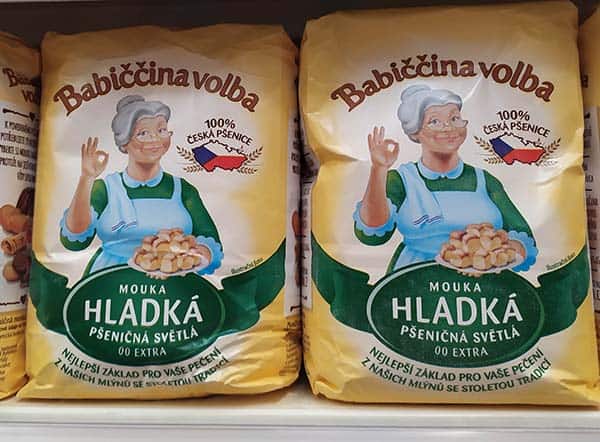Guía de la Harina Checa
There are many types of flour in the Czech Republic and it can be a little overwhelming if you aren’t familiar with the local classification of flour. Czech flour doesn’t have to be a mystery though and we’ve prepared a simple guide that will help you navigate through the flour isles in the Czech grocery stores!
 Classification
Classification
In the Czech Republic the basic types of flour are classified according to the intensity of grinding – so basically, if the grain is fine or coarse. This can be confusing if you’re used to standardization of flour according to use but don’t worry, it’s very easy.
Additionally, the name of the flour can also indicate the amount of gluten and, of course, what the flour’s made of.
Czech Flour Types
According to Coarseness
Hladká mouka
Hladká mouka is the most finely ground flower. It’s used for koláče (kolache), buchty, yeast dough in general, biscuits, pancakes and for thickening sauces (roux).

Harina semi-gruesa
Less fine than hladká mouka but can often be replaced by it in recipes. The name translated as half-coarse flour. Typical use in Czech cuisine is for bábovka (bundt cake or marble cake), gingerbread cookies, bublanina (sponge cake), types of batter like třené těsto (Rührteig in German) or lité těsto and also drobenka (rubbed dough which is used to sprinkle a certain type of cakes).

Hrubá mouka
This is coarse flour and it’s used for dumplings, pasta, drobenka (mentioned above). It can be replaced by krupice.

Krupice
Krupice is the most coarsely ground flour and it’s great for dumplings including the potato dumplings, for thickening soups and its variety krupička is used to make pap for toddlers and also a dish called krupičná kaše.
According to Parts of Grain
Depending on the parts of the grain that are being ground into the flour the Czech cuisine distinguishes the following types:
White flour
Only the center of the grain is used to make the white flour, in Czech bílá mouka or světlá mouka.
Whole-wheat flour
The whole caryopsis is ground into this type of flour giving it brown color. This flour is called celozrnná mouka.

Bread flour
Chlebová mouka contains parts of the caryopsis (part of the grain, shoot and coat) and is therefore something between the white flour and the whole-wheat flour.

According to Gluten Content
Gluten-free wheat flour
Normally, flour comes with gluten in the Czech Republic, as it is most typically made from wheat. However, with the awareness of gluten allergies on the rise the offer on gluten-free products is growing. An the same goes for the flours. Besides flours made from other plants than wheat – we will talk about them later – there are gluten-free wheat flours as well and special gluten-free mixtures. If you want gluten-free flour, look for bezlepková mouka.
High gluten content
Flours with high gluten content are used in the Czech cuisine especially for making pastries such as apple strudel (jablečný štrúdl). Gluten makes the dough more elastic. Usually the flours with high gluten content are called pizza mouka (pizza flour). You can also look for the letter T and the number behind it. The higher the number, the more whole-wheat the flour and the less gluten it contains.
Naturally gluten-free flours
There are plenty of natural gluten-free flours, you’ll find them in the next paragraph.

According to Plant
Cereal flour with gluten
Wheat flour
Wheat flour or pšeničná mouka is the most common type in Czech Republic. If you talk about flour without specifying the type, it is assumed that you talk about wheat flour.
Rye flour
Žitná mouka is often added into wheat bread dough because it’s healthier. It has greyish color and rises more difficultly that wheat flour.

Barley flour
If you want barley flour, look for ječná mouka. It is not very common though and you’ll rather find it in shops specializing in alternative food.
Oat flour
The oat flour or ovesná mouka isn’t very common but rolled oats are, you can find them in any grocery store and pass them through your blender at home.
Spelt flour
Spelt flour is a healthier type of wheat flour (read more about spelt here). And you’ll find it as špaldová mouka in the Czech stores.

Cereal flours gluten-free
- jáhlová mouka – millet flour
- rýžová mouka – rice flour
- pohanková mouka – buckwheat flour
- kukuřičná mouka – corn flour
- čiroková mouka – sorghum flour
- tapioková mouka – tapioca flour
Legume flours
- kukuřičná mouka – corn flour
- cizrnová mouka – chickpea flour
- čočková mouka – lentil flour
…
Nut and seed flours
- kokosová mouka – coconut flour
- madlová mouka – almond flour
- lískoořechová mouka – hazelnut flour
- arašídová mouka – peanut flour
- mouka z vlašských ořechů – walnut flour
- sezamová mouka – sesame seed flour
- lněná mouka – flaxseed flour
- mouka z dýňových semínek – pumpkin seed flour
…



